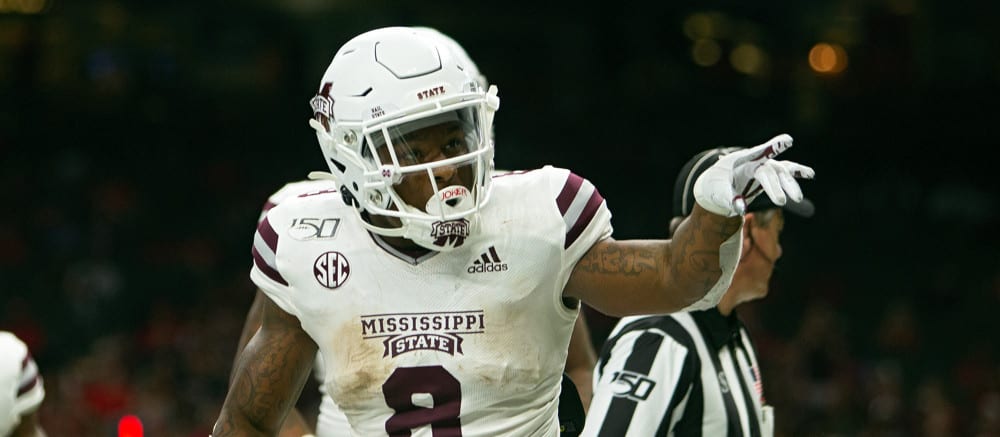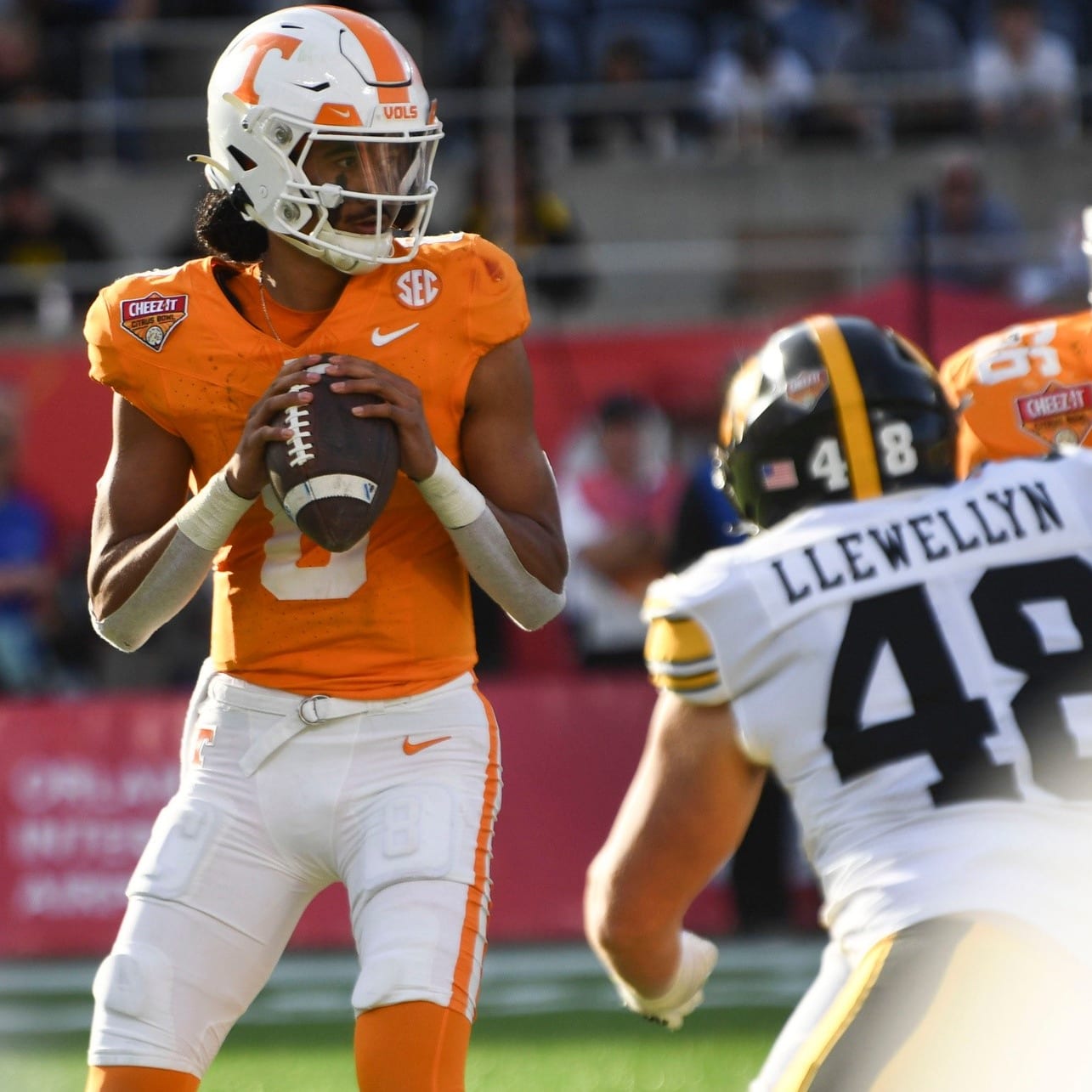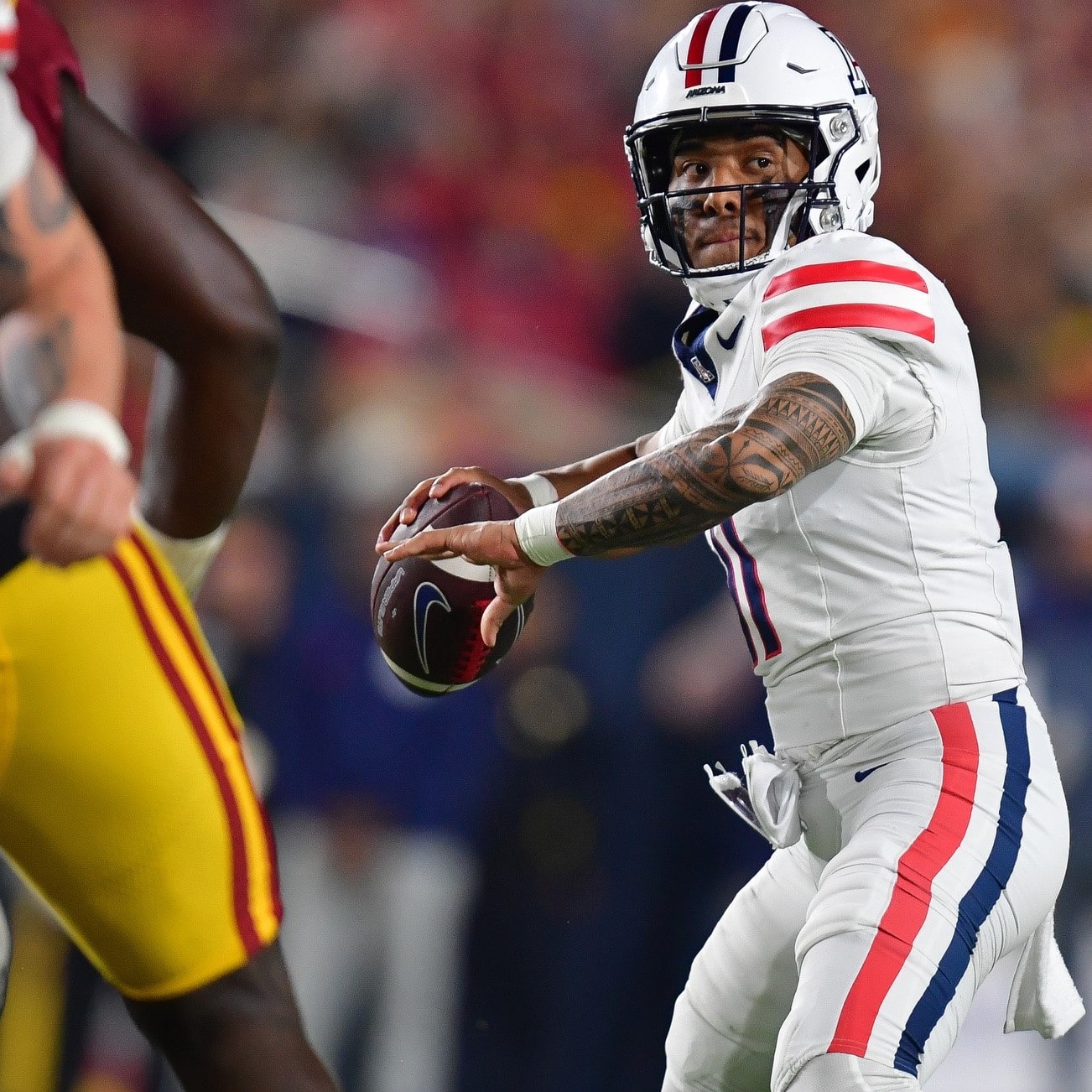This article is part of our Senior Bowl Viewing Guide series.
Welcome to this year's Senior Bowl Viewing Guide as things have gotten underway in Mobile for what is one of the more important events of the pre-draft process. With no centralized combine this year, this is likely the only chance for players from all schools to gather en masse for a chance to compete in front of NFL brass. The Senior Bowl is always important to the pre-draft process, but this year's may be particularly vital.
My goal is to identify a handful of players who will be on the redraft and dynasty radar that you may not be overly familiar with yet. I have rosy outlooks for a number of these players, but some outlooks are far less optimistic based on historical trends and precedents.
The headliners like Alabama's DeVonta Smith, Najee Harris, and Mac Jones need little introduction. Instead, I'll focus on players that are a bit under the radar at this stage of draft season.
Running Backs
Rhamondre Stevenson, Oklahoma (5-11, 227), National Team
Stevenson was already an interesting prospect coming into the week after posting 7.2 yards per carry and 13 touchdowns on 165 carries during his time with the Sooners. However, he was listed at 6-foot and 246 pounds at Oklahoma, which complicated his evaluation given that there aren't many data points to compare that frame to outside of Eddie Lacy or former Oklahoma running back, Samaje Perine.
Now that Stevenson checks in with a more conventional frame, he's easier to project. Stevenson is no Nick Chubb, but he could end up in an Isaiah Crowell or, at worst, a Peyton Barber-esque trajectory.
Again, the production was explosive, and the smaller body of work isn't overly concerning when you contextualize the Oklahoma backfield over the past two years. In 2019, Stevenson's first with the program as a JUCO transfer, Jalen Hurts and Kennedy Brooks accounted for 68 percent of the team's carries and Trey Sermon also took on some of the backfield work. There weren't many carries to go around -- Stevenson had just 64 attempts -- but he converted them into 515 yards (8.0 YPC) and six touchdowns. A suspension kept him out for the first five games of 2020, but Stevenson was productive after his reinstatement with 101 carries for 665 yards and seven scores.
Stevenson looks quick on film when you think he's over 240 pounds, so his weigh-in Tuesday changes things. The big question now becomes, Is Stevenson fast for a 227-pounder? We won't know until he officially tests at the Oklahoma Pro Day, but his performance in on-field work could give us some clues.
Now that Stevenson can be viewed under a more conventional lens, he becomes less of a project/unicorn and more of a running back that needs to be taken seriously in a class that is very fluid in terms of the pecking order.
Demetric Felton, UCLA (5-9, 186), National Team
Felton is a polarizing prospect. On the one hand, he's at an advanced age for a prospect as he'll be 23 when he reports to training camp and he's undersized for a running back. His frame compares to Raymond Calais and Donnel Pumphrey, neither of whom made much of a mark on Sundays, though it's still too early to write off Calais. The Felton optimists would point to his production and skill-set as his selling points, however. Felton had a unique role in 2019 with 86 carries for 331 yards and a touchdown while sharing the backfield with Joshua Kelley and UCLA used him plenty as a pass-catcher with 55 catches for 594 yards and four touchdowns on 73 targets. His usage was more conventional as the lead rusher in 2020, taking 132 carries for 668 yards and five touchdowns while adding 22 catches for 159 yards and three touchdowns on 27 targets.
He can also do this, which is fun.

Felton has a versatile skill set that should draw some interest from teams, but his frame likely prevents him from being an every-down player in an NFL backfield and his advanced age puts some of his production into question. Felton's best path could be a position switch to receiver, where he could be a Richie James type of player.
Kylin Hill, Mississippi State (5-10, 214), American Team
This is a shallow running back class and Hill is a serious candidate to move himself up some big boards with a strong pre-draft process, starting this week. There are very few "sure things" outside of Clemson's Travis Etienne, Alabama's Najee Harris and North Carolina's Javonte Williams in this running back class, so Hill has a great opportunity ahead of him.
Hill already has several factors working in his favor, including a strong weigh-in Tuesday, that give him a strong prospect grade. He showed that he could handle a heavy workload in 2019 with an SEC-high 18.6 carries per game, which he turned into 1,350 yards and 10 touchdowns. Mike Leach's arrival for the 2020 season was going to give Hill the chance to showcase his pass-catching ability that had warranted an incomplete grade coming into 2020. Unfortunately, we didn't get to see a full season of Hill as he opted out after three games. But his sample as a pass-catcher in those games is encouraging; he caught 23 of 29 targets for 237 yards and a touchdown.
Outside of Najee Harris, there's a strong chance Hill cements himself as the best running back participating this week. He has the frame, the tools, and the production to generate a Day 2 grade.
Larry Rountree, Missouri (5-10, 216) American Team
Rountree's production is among the most impressive of any runner in this class. The Missouri Tiger racked up 3,720 rushing yards on 746 carries (5.0) along with 40 rushing scores over his four years in Columbia. His frame is also encouraging with solid density for his height. The questions with Rountree center on his athleticism and pass-catching ability. Rountree was consistent at Missouri but not overly explosive-- he had just 12 runs of at least 20 yards over his last two seasons, a sample of 395 attempts. That raises concerns about his long speed. The frame part of the equation gets nullified if Rountree doesn't have baseline speed. That's what sunk Elijah Holyfield coming out of Georgia as a recent example. We won't know until he tests, but Rountree can start to quell those concerns this week if he matches his backfield counterparts athletically.
Khalil Herbert, Virginia Tech (5-8, 204) National Team
Herbert was one of my favorite stories from the 2020 season from a fantasy perspective. A grad transfer who spent his first three seasons at Kansas, Herbert erupted for a career year in Blacksburg with 154 carries for 1,182 yards and eight touchdowns. His 7.68 YPC average was tops among all runners with at least 150 carries. Herbert's detractors could point to shaky production at Kansas and Virginia Tech's top-tier offensive line paving the way for his big 2020. However, Herbert averaged almost 9.0 yards per carry over four games at Kansas in 2019 (43 carries) and he averaged 5.53 YPC as a freshman in 2017 when Kansas, as a team, averaged 3.15. Put another way, Herbert was impressive for most of his college career, it's just that the Kansas factor makes that a little tougher to see at first glance.
Herbert has a compact frame similar to a D'Andre Swift or Darrell Henderson, though those two players showcased much more versatility during their collegiate careers than the former Hokie. Pass-catching ability, or lack thereof, will be something that needs to be examined during the predraft process as Herbert had all of 28 catches for 255 yards in 38 career games. Herbert's big-play ability helped carry him to this point and it will be fascinating to see if that explosiveness translates this week and beyond. Looking ahead, Herbert could be this year's version of JaMycal Hasty, with the caveat that he actually gets drafted.
Wide Receivers
D'Wayne Eskridge, Western Michigan (5-9, 180), National Team
Speed is the name of the game for Eskridge as the Western Michigan product parlayed his track background into impressive production during his time in Kalamazoo. Eskridge, who won state titles in the 100m and 200m dash as a senior in high school and reportedly clocked a 4.33 (laser-timed) 40 in 2018, averaged 20.4 yards per reception over 104 catches in college. His best season came as a senior as he caught 33 of 52 targets for 768 yards (14.8 YPT) and eight scores, but his 500-yard freshman season in 2017 and his 700-yard season as a sophomore suggest that he didn't only need to be older than the competition to have success.

Eskridge played both corner and receiver before suffering a season-ending collarbone injury in 2019, so it will be interesting to monitor whether teams want to see him work on the other side of the ball in Mobile. If Eskridge is strictly working at receiver, he'll need to show that there's more in his arsenal than just speed, even though that will be the attribute that carries him to the next level. I'm betting that teams will come away impressed by the MAC speedster by the time Senior Bowl week wraps up.
Sage Surratt, Wake Forest (6-2, 215), National Team
Surratt was a player I was very high on after 2019 and while his decision to opt-out of this past season was completely justified, it leaves him with some ground to make up during the pre-draft process.
The last time we saw Surratt he was torching ACC competition, racking up 66 catches on 102 targets for 1,001 yards (9.81 YPT) and 11 scores through nine games before a shoulder injury cut his season short. Where Surratt wins is with his physicality. At 6-foot-3 and 215 pounds, Surratt uses his frame and strength to dominate smaller corners.

However, Surratt will need to show athleticism and the ability to separate because those were some concerns that popped up when I re-watched him.
Nico Collins, Michigan (6-4, 215), National Team
Collins fell out off my radar a bit in 2020, though that's my own fault rather than his. Like Surratt, Collins opted out of this past season after putting together a strong resume in his first few years in college. His best years came in 2018 and 2019 as a true sophomore and true junior. He caught 38 of 54 targets for 632 yards and six touchdowns in 2018 and followed that up with 37 catches for 729 yards and seven touchdowns on 68 targets the following season.
What's impressive is that Donovan Peoples-Jones and Tarik Black were the headliners of that Michigan recruiting class, and yet it was Collins who posted the better production between the three of them. Not to say Collins was some slouch as a recruit -- he was a four-star in his own right -- but DPJ and Black were supposed to be the future of the receiver position at Michigan and it was Collins who ended up as the best of the three.
Collins has a big frame and strong hands but his tools don't stop there. He has impressive size-adjusted speed from what I can tell as there were several instances of him running away from the defense after the catch.
A Tim Patrick trajectory could be in play for Collins, though the hope would be that he finds his footing faster than his age-26 season.
Cornell Powell, Clemson (6-0, 205), American Team
Powell was someone I had all but written off before this season. He had a total of 28 catches for 242 yards on 43 targets entering 2020, but the Justyn Ross absence opened a door for Powell to finally have a major role in the Clemson offense and he made the most of that opportunity. Powell answered the bell with 53 catches for 882 yards and seven touchdowns on 79 targets and 11 of his catches went for 25-or-more yards. Of course, this makes him a late breakout, which always gives some analysts pause regarding a player's trajectory. Generally, you want to see players start producing early in their careers so that later production isn't derived from age advantage.
Powell basically had to have a season like this to even be on the radar after those first three seasons. I'll even concede this. But I won't use Powell's lack of production prior to this season against him too much. Not many receivers in the country would be getting snaps and targets over Tee Higgins, Justyn Ross, or even Amari Rodgers.
Powell's big selling point was his downfield ability in 2020, so showing he can pose that threat against the competition this week will further solidify his stock and keep him on the rise. A poor week could be very costly for a player like Powell given his age and late breakout. A lot on the line for this Clemson receiver this week.
Ben Skowronek, Notre Dame (6-2, 211), National Team
Skowronek is one of several players who improved their draft stock as a graduate transfer in 2020. The former Northwestern Wildcat put on the gold helmet this past season and was a factor for the Irish, catching 29 of 43 targets for 439 yards. He performed above the baseline of the Notre Dame passing offense (9.8 YPT compared to the team's 7.9 YPA) and has an intriguing frame at just under 6-foot-3 and 211 pounds. Skowronek is similar to Zach Pascal or Travis Fulgham in terms of traits and play style, but his peak college season doesn't compare to either of them, although both played at a lower level of competition.
Skowronek likely profiles as a late Day 3 selection at this stage but I was impressed by his senior season at Notre Dame and as a big-bodied receiver with some flashes to his game, I'll be keeping an eye on his progress throughout the week.
Tight Ends
Tony Poljan, Virginia (6-7, 265), National Team
Poljan is an interesting case as there aren't a ton of success stories among tight ends with this frame. Jimmy Graham would be the poster child, but he's the exception and not the rule. Scott Chandler, Jesse James, and Joe Fauria are other physical comps with varying degrees of NFL success.
Poljan is also interesting in that he's a converted quarterback. He spent his first two years behind center at Central Michigan but moved to tight end with a new coaching staff coming in 2019. Poljan found immediate success there, catching 33 of 49 targets for 496 yards and four touchdowns before transferring to a higher level of competition for his final season. He acquitted himself well in the one year at Virginia, catching 38 of 59 targets for 411 yards (7.0 YPT) and a team-high six touchdowns.
Poljan is still learning the ropes at the tight end position but he's got intriguing tools and traits that could help solidify his stock as a Day 3 prospect.
Kenny Yeboah, Mississippi (6-3, 247), National Team
Another grad transfer, Yeboah started his career at Temple before bolstering his NFL bona fides with a strong season in the SEC. He was a 7.8 YPT player during his time at Temple and never saw more than 28 targets in a full season. Yeboah showed there was another level to his game in Oxford, catching 27 of 37 targets for 524 yards (14.2 YPT) and six touchdowns as part of an electric Ole Miss passing attack.
The 6-foot-3 mark may look less than ideal, but he was 6-foot-3 7/8, so we won't hold that against him too much. Plus, his wingspan (80 inches) helps smooth over any height deficiency and ranks well above average for tight ends according to the MockDraftable database.
This is a tight end class that is wide open beyond TE1 -- Florida's Kyle Pitts -- so there is room for a player like Yeboah to drastically alter his draft stock this week. Yeboah's explosive ability that was unlocked at Mississippi figures to be on display in Mobile throughout this event. Look for Yeboah to leave the Senior Bowl with his stock trending firmly upward.












